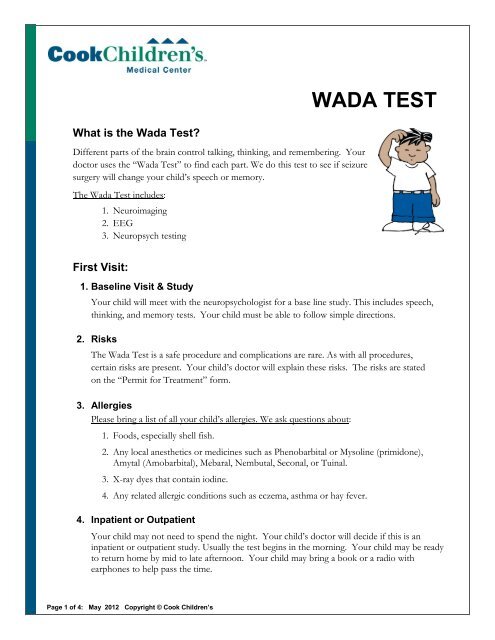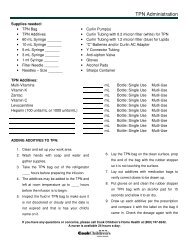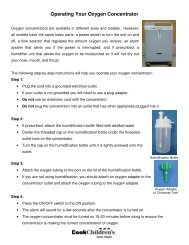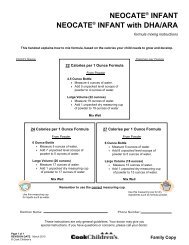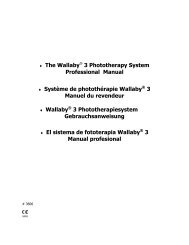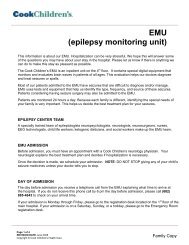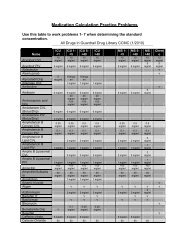WADA TEST - Cook Children's
WADA TEST - Cook Children's
WADA TEST - Cook Children's
Create successful ePaper yourself
Turn your PDF publications into a flip-book with our unique Google optimized e-Paper software.
<strong>WADA</strong> <strong>TEST</strong><br />
What is the Wada Test?<br />
Different parts of the brain control talking, thinking, and remembering. Your<br />
doctor uses the “Wada Test” to find each part. We do this test to see if seizure<br />
surgery will change your child’s speech or memory.<br />
The Wada Test includes:<br />
1. Neuroimaging<br />
2. EEG<br />
3. Neuropsych testing<br />
First Visit:<br />
1. Baseline Visit & Study<br />
Your child will meet with the neuropsychologist for a base line study. This includes speech,<br />
thinking, and memory tests. Your child must be able to follow simple directions.<br />
2. Risks<br />
The Wada Test is a safe procedure and complications are rare. As with all procedures,<br />
certain risks are present. Your child’s doctor will explain these risks. The risks are stated<br />
on the “Permit for Treatment” form.<br />
3. Allergies<br />
Please bring a list of all your child’s allergies. We ask questions about:<br />
1. Foods, especially shell fish.<br />
2. Any local anesthetics or medicines such as Phenobarbital or Mysoline (primidone),<br />
Amytal (Amobarbital), Mebaral, Nembutal, Seconal, or Tuinal.<br />
3. X-ray dyes that contain iodine.<br />
4. Any related allergic conditions such as eczema, asthma or hay fever.<br />
4. Inpatient or Outpatient<br />
Your child may not need to spend the night. Your child’s doctor will decide if this is an<br />
inpatient or outpatient study. Usually the test begins in the morning. Your child may be ready<br />
to return home by mid to late afternoon. Your child may bring a book or a radio with<br />
earphones to help pass the time.<br />
Page 1 of 4: May 2012 Copyright © <strong>Cook</strong> Children’s
It is important for your child to know what is happening. Please let us<br />
know if you have any questions or would like help explaining this to your child.<br />
DAY OF THE <strong>WADA</strong> <strong>TEST</strong><br />
Your doctor will meet with you and answer any last minute questions. Your child will:<br />
Put on a hospital gown<br />
Enter an X-ray room<br />
Lie down on a firm bed<br />
Numbing Medicine<br />
Your doctor gives your child a small shot of numbing medicine on the top part of the leg (called<br />
the groin). Your child may feel slight pressure and a sting, but it only lasts a few seconds. Most<br />
children say that this doesn’t hurt.<br />
Placing the Catheter<br />
When the groin is numb, the doctor makes a small incision and places a tiny, flexible tube<br />
(catheter) into the artery.<br />
The doctor gently guides the catheter into the arteries.<br />
A television-like screen called fluoroscopy shows us where the catheter is going.<br />
When the catheter reaches the right artery, we give the first medicine.<br />
This medicine goes into the catheter and flows into your arteries.<br />
We can then see the arteries on the fluoroscopy screen.<br />
Your child may have a warm feeling for about 10 to 20 seconds.<br />
At the same time, there might be a loud clicking sound. This is the x-ray machine taking<br />
pictures of the medicine as it flows in the arteries. It is very important to lie very still at this time.<br />
During the Wada Test<br />
Right & Left Sides of Brain<br />
The brain is divided into the right and left side. Each side controls the opposite side of the body.<br />
Right side of brain controls left side of body.<br />
Left side of brain controls right side of body.<br />
Medicine<br />
The first medicine only goes to one side of your brain.<br />
This side of the brain will fall asleep.<br />
This causes the opposite side of the body to fall asleep. The non-medicine side stays<br />
awake and you stay awake too<br />
You cannot move your arms or legs on the sleeping side until the medicine wears off.<br />
If this side of the brain controls speech, you may not be able to talk.<br />
This weakness is temporary, usually lasting only 5 to 15 minutes.<br />
During this time, when the arm and leg are asleep, we ask simple questions.<br />
Page 2 of 4: May 2012 Copyright © <strong>Cook</strong> Children’s
Questions<br />
1. Testing Speech: We ask your child to read words and name objects, pictures, shapes<br />
and colors. Your child answers simple questions about the objects and repeats brief<br />
sentences. (is it round, do you eat this, etc.).<br />
2. Testing Memory: Later in the test, we ask the child to name the objects shown at the<br />
beginning of the test.<br />
Sometimes we test only one side of the brain. Sometimes we need to wait a few minutes for the<br />
arm and leg to wake up, and then test the other side. We use hand and arm strength to measure<br />
how sleepy your child has become.<br />
HOW LONG DOES <strong>WADA</strong> <strong>TEST</strong> TAKE?<br />
You can expect your child to stay on the X-ray table for 1 to 2 hours. The picture-taking<br />
process can be as little as 15 minutes.<br />
After Wada Test<br />
There are no Stitches.<br />
We remove the catheter<br />
We press on the catheter site for 10 to 15 minutes.<br />
We cover the site with a small bandage.<br />
Inpatient<br />
Your child returns to the hospital room by stretcher. It is very important to lie flat during this<br />
time. This keeps the catheter site from bleeding. Your child will need to keep their legs straight<br />
with no bending. We help your child do this. For the next few hours your nurse will:<br />
Check your child’s blood pressure and pulse<br />
Look at the bandage.<br />
Bring your child something to eat and drink if they are hungry<br />
Outpatient<br />
You stay in the recovery area of the Radiology Department for about 4 to 5 hours.<br />
Your child must lie flat during this time: this is very important! This keeps the catheter site from<br />
bleeding. Your child will need to keep their legs straight with no bending. We help you do this.<br />
For the next few hours your nurse will:<br />
Check your child’s blood pressure and pulse<br />
Look at the bandage.<br />
Bring your child something to eat and drink if they are hungry<br />
Page 3 of 4: May 2012 Copyright © <strong>Cook</strong> Children’s
Going Home<br />
If your child continues to do well, you will be sent home. A nurse will explain what to do at<br />
home and will give you written instructions for home care.<br />
After the test, the catheter site may be tender and bruised.<br />
You may apply ice packs and elevate your child’s leg with a pillow to ease any pain.<br />
Always tell the nurse or doctor immediately of any pain or unusual feelings or concerns.<br />
Test Results<br />
The result of the test will be sent to your doctor. Please check with your doctor for a time to<br />
discuss the results. Information from the <strong>WADA</strong> test helps us decide on the best type of<br />
surgery.<br />
No Driving Home for Teens<br />
Even if you have a driving teen, please do not drive home after the Wada Test<br />
My Notes:<br />
These instructions are only general guidelines. Your doctors may give you<br />
special instructions. If you have any questions or concerns, please call your doctor.<br />
Page 4 of 4: May 2012 Copyright © <strong>Cook</strong> Children’s


